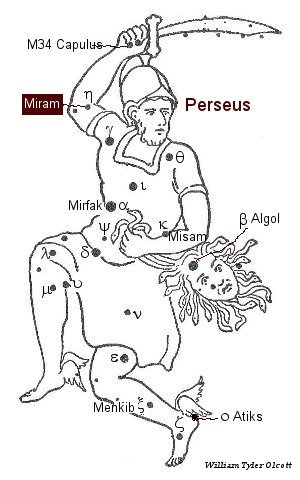| Fixed star: MIRAM | |
| Constellation: Eta (η) Perseus | |
| Longitude 1900: 27TAU19 | Longitude 2000: 28TAU42 |
| Declination 1900: +55.29′ | Declination 2000: +55.53′ |
| Right ascension: 02h 50m | Latitude: +37.28′ |
| Spectral class: K4 | Magnitude: 3.9 |
The history of the star: Miram
from p.334 of Star Names, Richard Hinckley Allen, 1889.
[A scanned copy can be viewed on this webpage
Eta (η) Perseus, Miram, is a double star, 5 and 8.5, orange and smalt blue, in the right arm of the Champion.
In China eta (η Miram), with gamma (γ), was Tien Chuen, Heaven’s Ship. But it is noticeable in having three small stars on one side nearly in line, and one on the other, forming a miniature representation of Jupiter and his satellites.
Star Names, Their Lore and Meaning, Richard Hinckley Allen, 1889].
The astrological influences of the constellation Perseus
Legend: Zeus visited Danae in the form of a shower of gold and got her pregnant with Perseus. As a young man Perseus undertook a mission to kill the Medusa. He was furnished with the sword, cap and wings of Mercury and the shield of Minerva. He killed the Medusa by cutting off her head and afterwards killed the sea monster Cetus and then rescued and married Andromeda. Perseus founded a city, having dropped his cap or found a mushroom (both named myces) at Mycenae. [Robson, p.56.]
Influences: According to Ptolemy, Perseus is like Jupiter and Saturn. It is said to give an intelligent, strong, bold and adventurous nature, but a tendency to lying. By the Kabalists it is associated with the Hebrew letter Lamed and the 12th Tarot Trump "The Hanged Man." [Robson, p.56.]
The constellation is indicative of events effecting large numbers of people, especially those events caused by major meteorological phenomena. When prominent in a natal chart it is said to denote adventurous individuals, but also those who are less than honest in their dealings with others. [Fixed Stars and Judicial Astrology, George Noonan, 1990, p.14.]
References:
Fixed Stars and Constellations in Astrology, Vivian E. Robson, 1923].
